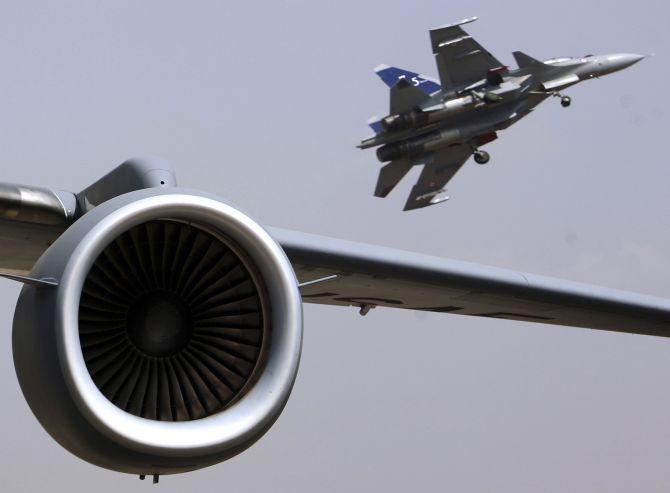
Low equipment price, operational durability in climatic extremes and platform familiarity are reasons for Russia's success with India as a weapons supplier, says Rahul Bedi.
Prime Minister Manmohan Singh's visit to Moscow and talks with President Vladimir Putin on October 21 will doubtlessly reconfirm India's dependence on Russian materiel.
'Bilateral defence ties between India and Russia have transformed radically, evolving from a buyer-seller relationship to one involving licensed production and more recently into one envisaging joint research, development and production of advanced defence systems,' India's envoy to Moscow Ajai Malhotra declared ahead of Dr Singh's participation in the 14th edition of the Delhi-Moscow summit.
India annually conducts $1,500 million (Rs 9,274.5 crores/Rs 92 billion) worth of defence business with Russia.
Since the early 1960s India has acquired military equipment worth over $40 billion (Rs 247,320 crores/Rs 2.47 trillion) from Moscow. This constitutes over 65 per cent of the Indian military's inventory.
According to recent assessments by the Russian Centre for Analysis of International Weapons Trade, India will account for around 54.4 per cent of all weapon exports by Moscow between 2010 and 2013 that are estimated at over $15 billion (Rs 92,745 crores/Rs 927 billion).
Please ...
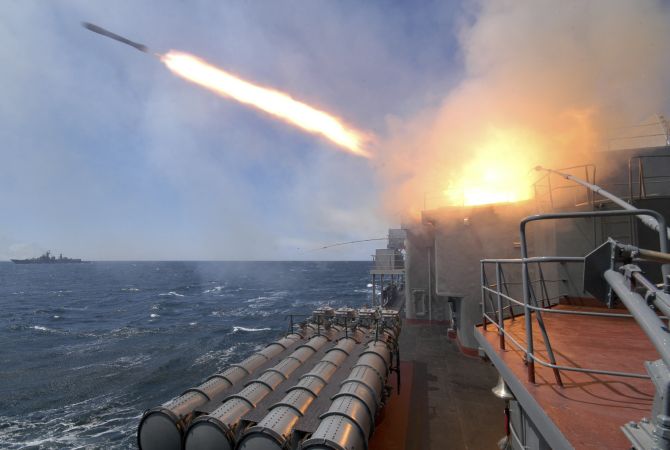
This includes combat and transport aircraft, naval fighters, conventional and nuclear submarines, warships, main battle tanks, field artillery, infantry combat vehicles, varied helicopters and a vast assortment of ordnance and missiles.
A large proportion of this equipment is licence-built by India's public sector via technology transfers.
"Russia is unlikely for several decades to be dislodged as India's principal weapons supplier even by a combination of the US, France, Israel, each one of whom have individually increased their defence exports to Delhi in recent years," says Lieutenant General Vijay Kapoor (retd).
The three principal reasons, he added, for Russia's continuing success with India in this field remains low equipment price and operational durability in climatic extremes and platform familiarity for generations of Service personnel.
Consequently, the bulk of the Indian Air Force's 32-odd fighter squadrons comprise Russian platforms including the multi-role Su-30MKI whose numbers by 2017 will rise to 272, making it the single largest fighter type in the force.
The majority of the IAF's transport aircraft are Russian whilst India remains the world's largest operator of Mi-17/Mi-8 tactical transport helicopters with over 200 of them in service.
The Indian Navy's submarine and warship fleet too is largely Russian in both origin and design whilst 45 Mig-29Ks will form the air arm of its two aircraft carriers by 2017-2018.
Over 95 per cent of the Indian Army's armour fleet of around 2,500 main battle tanks include Russian T-72s and T-90S, whilst over 2,000 of its infantry combat vehicles are exclusively from the Soviet era.
Besides, the two sides have successfully developed the anti-ship BrahMos cruise missile with a 292km range which has been fitted onto the navy's frontline warships and is soon expected to arm its submarines.
Trials to test fire the BrahMos's air launched version from a specially modified Su-30MKI is reportedly imminent and export possibilities for the cruise missile continue to be negotiated.
On the eve of Prime Minister Manmohan Singh's Moscow trip the Cabinet Committee on Security he heads on October 17 approved indefinitely the partnership to co-produce the BrahMos removing a persistent irritant in bilateral military cooperation.
The two sides are also jointly developing the long-delayed Multi-role Transport Aircraft of which 100 are earmarked for Russia, 45 for the IAF and 60 for export. And in recent years India has secured access to the Russian-built Global Navigation Satellite System or GLONASS as an alternative to the US-controlled Global Positioning System.
Please ...
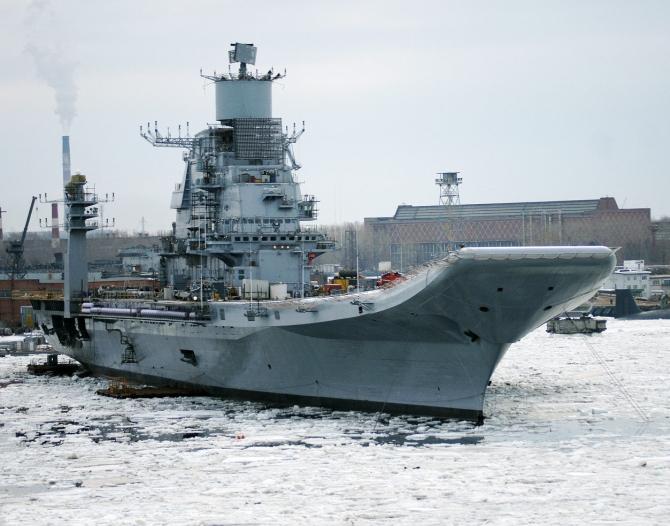
Fearful of competition from Israeli, US and European arms consortiums, senior Russian analysts recently declared that Moscow could offer India badly-needed strategic military know-how in order to retain sway over its largest materiel procurer.
'Growing international competition for the Indian defence market will push Russia to expand its cooperation with India into new sectors where it has no rivals, such as strategic weapons and technologies,' Konstantin Makienko of the Centre for Analysis of Strategies and Technologies declared in Moscow in October 2010.
Makienko suggested that the two countries could diversify their defence ties into nuclear submarine technologies despite continuing international restrictions against India.
'India's de facto joining of the nuclear club makes such restrictions rather pointless,' he declared, adding that Russia was interested in strengthening Delhi's defence potential without any limitations.
He was referring to the 45-nation Nuclear Suppliers Group, responsible for regulating global nuclear trade approving a US-backed proposal in 2008 permitting India to conduct civilian atomic commerce whilst retaining its strategic weapons programme.
Russia's involvement in helping India miniaturise the 80MW pressurised water reactor fueled by enriched uranium aboard its indigenously designed ballistic missile submarine, the INS Arihant (Enemy Destroyer) has long been an open, though downplayed secret amongst naval, atomic and strategic community personnel.
Official sources recently indicated that Russia would, in all likelihood, also assist the Defence Research and Development Organisation in designing the 3 to 5 follow-on SSBNs at the secretive Ship Building Centre in Visakhapatnam.
Please ...
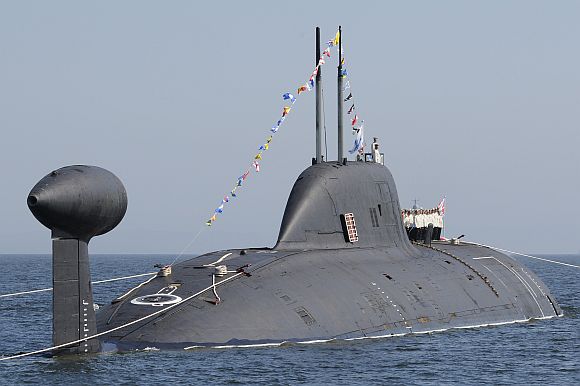
India is also on the verge of leasing a second Russian nuclear powered attack submarine as a follow on to the INS Chakra it leased for 10 years for around $920 million. The INS Chakra was inducted into the Indian Navy last April.
'India can afford it (the second SSN). It is reasonable,' Defence Minister A K Antony said on the sidelines of the induction ceremony.
Chakra that will serve as a training platform for the Arihant was one of two Russian SSNs that India planned on leasing in 2004.
This classified deal was initially agreed upon by the National Democratic Alliance administration along with the procurement of the Admiral Gorshkov, the 44,750 ton Kiev-class aircraft carrier for the price of its refit, revised recently to $2.3 billion.
But the second SSN lease was deferred by the Congress Party-led federal coalition around 2005 only to be resurrected recently at the Indian Navy's insistence.
Earlier, in 1988, the navy had leased a Soviet Charlie-I class SSN for three years to gain operational experience with nuclear submarines, with plans on clinching similar agreements for six such boats. But the Soviet Union's disintegration foreclosed that possibility.
The sale of nuclear submarines is forbidden by international treaties, but leases are permitted provided the platforms are not armed with missiles with ranges of over 300 km. 'Only Russia is capable of leasing nuclear submarines to India. No other country would take such a step,' a vice-admiral said.
Please ...
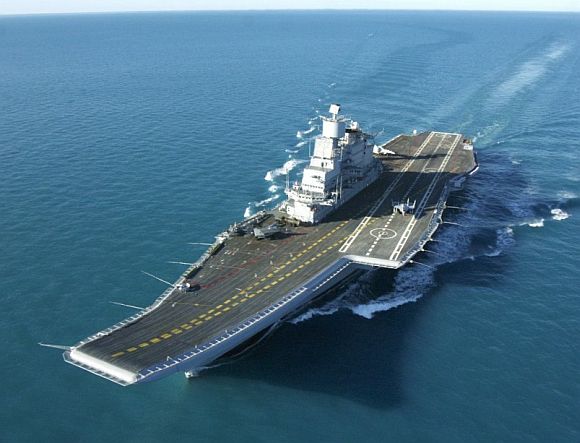
Despite such alluring overtures, there remains an undercurrent of dissatisfaction with Russia, both in the ministry of dDefence and the three Services, primarily over equipment cost and time overruns.
The initial cost of retrofitting the Gorshkov, for instance, was $974 million (Rs 6,022.2 crores/Rs 60 billion) but within a few years it had soared almost three times to $2.3 billion (Rs 14,220.9 crores/Rs 142 billion). Its delivery to the navy scheduled for November stands delayed by five years.
Astronomically high operating costs of fuel-intensive, relatively technologically inadequate Russian equipment alongside incompetent after-sales product support including access to spares remain a recurring concern for India's military.
This, in turn, had triggered the defence ministry's insistence on life cycle costing for future materiel purchases resulting in Russia losing out to the US and the Europeans in recent tenders.
These include the procurement of 15 heavy lift and 22 attack helicopters, six mid-air refuellers and the lucrative Medium Multi-Role Combat Aircraft requirement for 126 fighters which have been awarded to the US, Europeans and France respectively.
Meanwhile, the IAF is concerned over the inadequate technological share accorded to India by Russia, the lead partner in the $35 billion (Rs 216,405 crores/Rs 215 trillion) joint Fifth Generation Fighter Aircraft project.
Under the FGFA programme, the IAF plans on inducting 220 to 250 of the advanced Russian fighters 2022 onwards, but in recent weeks its concern has mounted over India's share of work in the project following revelations that this is no more than 15 per cent. This, despite India having been promised greater technological participation.
'At the moment it (the FGFA) is not very much in favour of Indian development and we are flagging it through the government,' Deputy Air Chief Air Marshal S Kumar said in New Delhi on October 17. 'It should be much more focused towards indigenous development capability, he stated.
...
...